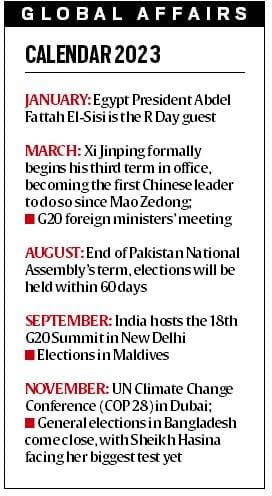Description

Copyright infringement is not intended
Context: After a tumultuous year in global geopolitics — with the Russia-Ukraine war and China’s belligerence at India’s doorstep — India is entering 2023 with challenges and opportunities staring at it on the diplomatic and military fronts.
Details:
- With the war in Europe coming after two brutal years of the pandemic, 2022 is being compared with disruptive periods in the past — 1962 (India-China war, Cuban missile crisis), 1979 (Iranian revolution, invasion of Afghanistan, siege of Mecca), 1989 (fall of Berlin Wall), 1991 (Collapse of the Soviet Union, Economic reforms in India, Gulf War I), 2001 (9/11 terror attack, fall of Taliban, war on terror), 2008 (global financial crisis, 26/11 Mumbai terror attack).
- With a highly infectious COVID-19 variant spreading across China, a level of uncertainty has again gripped the world. And an economic downturn looms large on the horizon.

Six hard realities:
- Russia-Ukrainewar: The Russian invasion of Ukraine has upended the global order in place since World War II, impacted the world’s food and energy security, and is pushing the global economy towards a recession. The nuclear rhetoric from Russian leaders has caused anxiety, while the strategic embrace of Russia and China is another worry.
- China’s aggression:The Ukraine war has also made the world sit up and look at China’s aggression in the Indo-Pacific. Closer home, India is facing that aggression on its border, with a skirmish in Arunachal Pradesh after the 2020 Galwan clashes that killed 20 Indian soldiers. That Beijing is belligerent can be seen in its recent activities in the South China Sea, where it has been observed to carry out construction on an island.
- Ties with the West being tested: Thanks to an aggressive Russia, India’s ties with the West are going through a stress test. New Delhi’s diplomatic tightrope walk has often been seen by its partners in Washington and Europe as opportunistic, with Delhi seen as following its interests and not being guided by “shared values”. European partners, which import more energy than India, have scoffed at India’s buying of cheap oil from sanctions-hit Russia. While Washington has been understanding, the absence of a full-time US ambassador — even after almost two years of the Biden administration — is perceived to have impacted communication
- Taliban engagement begins:While India has made its red lines clear on the menace of extremism and rights of minorities and women, signalling long-term commitment to Afghanistan’s future, it has made a commitment of USD 80 million — over and above its USD 3 billion commitment in the last two decades — for improving the lives of Afghans. This means Delhi is finally looking at the Taliban as a political actor, although it is influenced and even controlled by Pakistan’s military establishment.
- Pakistan turmoil:Pakistan saw a new government. The rhetoric against India has lowered a bit, but there has been no headway in bilateral ties. Towards the end of the year, Pakistan got a new Army chief which, many say, is the real transition of power in the country where the military-intelligence establishment has a complete veto on foreign and defence issues.
- Neighbourhood in crisis:
- The Sri Lankan economic and political crisis was a major challenge in the neighbourhood. India opened its purse strings and gave humanitarian aid, fuel, medicines, more than any other country in such a short period of time. Delhi is also helping the island country negotiate an economic debt relief package from the International Monetary Fund. With China as a rival in Sri Lanka, Delhi wants a government that understands India’s security and strategic interests.
- Engagement with Myanmar has continued in low-key visits and assistance to the military junta regime in Yangon and Delhi has sought to not isolate the regime in Nay Pyi Taw, unlike the western partners. The key impact has been the influx of refugees from Myanmar to the north-eastern states through the porous borders and concern about non-state actors fomenting trouble in the north-east.
.jpg)
Six challenges and opportunities for 2023:
- Dealing with China:The December 9 Arunachal clashes have shown that Beijing is challenging the status quo, not just in eastern Ladakh but in other sectors along the 3,500-km border with India. With President Xi getting a third term and emerging as China’s most powerful leader since Mao Zedong, the road ahead has become more challenging. As China sees itself as a superpower and whose time has come, more clashes and competing interests with India are likely, which will have to be resolved through negotiations.
- Engaging with Russia: The border standoff with China has shown Russia’s importance in India’s strategic calculus. Russia has been a reliable supplier of defence equipment for the past seven decades, and despite diversification to the US, France and Israel among others, Moscow still dominates the field. In the post Cold War-era, economic relations have formed the “new strategic basis” for Sino-Russian relations. China is Russia’s biggest trading partner and the largest Asian investor in Russia. China sees Russia as a powerhouse of raw material and a growing market for its consumer goods. The West’s approach towards Russia after the war has brought Moscow much closer to China. Delhi’s effort will be to engage with both Russia and the West, and put its strategic defence and national security interests first.
- G20 as a global stage:The hosting of the G20 summit will be one of the biggest portrayals of India’s rise at the global stage months ahead of the General Elections in 2024. New Delhi, which has already positioned itself as the “voice of the Global South” — a reference to the developing and the less-developed countries — will seek to put its priorities on the global forum.
- Ties with the West:With India buying cheap oil and not joining the West against Russia, Delhi will have to work to assuage the concerns of European and American partners. In fact, the G20 preparations will give some opportunity to do that.
- Challenge in the neighbourhood: While Sri Lanka will continue to demand India’s humanitarian, financial and political attention in the new year, New Delhi will also be part of political conversation in Maldives. The Maldives is going to polls in September, and an “India Out” campaign is likely to fire up the political debate. Delhi will be watching closely as political parties try to project India as the bully and a big brother. Bangladesh also goes into election mode in 2023, with polls scheduled for January 2024 after an iron-fist reign of Sheikh Hasina. India will be looking at her prospects after a long and uninterrupted political journey that has brought security in India’s eastern states. Nepal witnessed a dramatic turn of events, with rebel-turned-politician Pushpa Kamal Dahal ‘Prachanda’ becoming the Prime Minister and former PM K P Oli — a known India-baiter in recent years — holding the keys to the government. This will pose significant challenge for Delhi, which has seen Beijing’s influence grow in Kathmandu in recent years.
- Pakistan’s crucial year: Elections in Pakistan are scheduled for later in 2023. This will again be a contest to watch out for, with Imran Khan holding massive rallies on one hand, and Sharif-Bhutto-Zardari going into the

https://indianexpress.com/article/explained/explained-global/china-west-g20-opportunities-concerns-8347510/













